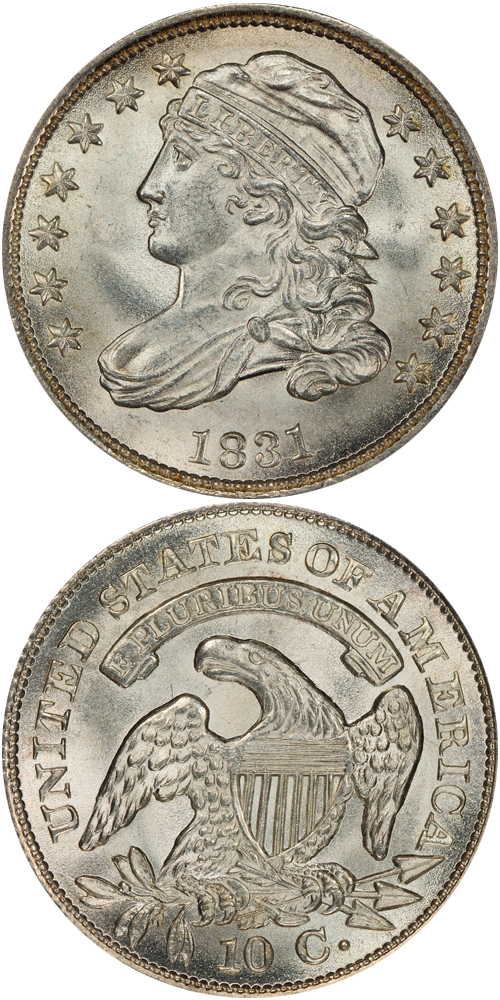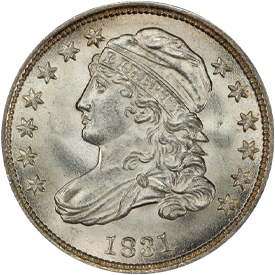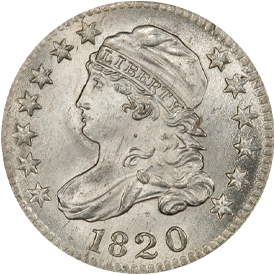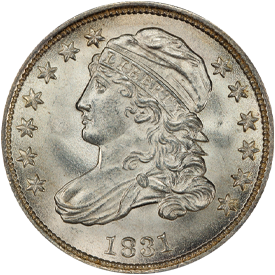Unlike the half dime, which went on hiatus from 1806 through 1828, some dimes were coined during this period, though occasional breaks were taken. John Reich’s Capped Bust design, which had made its debut on the half dollar in 1807 made its appearance on the dime in 1809, the second denomination to adopt it.
In the earlier years, (1809-1827) the coins were struck with an open collar, giving them a wider border and a slightly larger diameter than subsequent pieces. Starting in 1828, a closed collar was employed, which resulted in a small reduction in the diameter and a more distinct and sharper border. The portrait of Liberty was also slightly modified, particularly around the facial features.
The key in the earlier dates is the 1822 while in the later dates, a variety of the 1829 with the Curl Base 2 will be the rarity. Aside from those two coins, most of the other dates and varieties are relatively available.
Further Reading
No dimes were made with the date 1808. In 1809 coinage was resumed, and a new design made its appearance, the Capped Bust style similar to that used on contemporary half dollars (beginning in 1807 with the half dollar denomination). The reverse depicts an eagle perched on a branch and arrows. John Reich is believed to have engraved this style.
Traditionally, numismatists have read that dimes from 1809 through early 1828 were made of a slightly larger diameter than those from late 1828 through 1837, with the former being made without a collar or in an "open collar" and the latter being the "closed collar" type. A detailed explanation in the Early United States Dimes 1796-1837 book relates that there is no clear delineation between "large" and "small" diameter pieces. Diameters gradually reduce from 1827 to 1832, and then they gradually increase again from 1834 to 1837. The "open collar" process was used for dimes dated from 1809 through 1827, and the "closed collar" was used for those from 1828 through 1837. In contradiction to what was believed earlier, it is now known that both varieties of 1828-large date and small date-were struck with closed collars and both have the same diameter. For a detailed explanation, the reader is referred to the aforementioned text.
Coinage was not continuous during this span, and several gaps occur among the earlier years. Interesting varieties include the overdates 1811/09, 1823/2, 1824/2, a piece described as 1827/5 (which I do not recall ever having seen), and the 1830/29. The rarity of the latter is hard to determine for the overdate is very difficult to ascertain on all but the finest specimens, and more examples may exist than is believed. For the year 1828 two notable varieties exist, the large date with curl base 2, and the small date with square base 2.
A curious variety occurs among 1814 and 1820 dimes: The same reverse die was used in both of these years to create the so-called STATESOFAMERICA variety, which consists of three words close together without appropriate spacing.
Tradition rears its head again in listings of dimes of this era, and thus such varieties as 1823/2 with small E's or large E's in the reverse legend, 1829 with small 10c, medium 10c, or large 10c, and other relatively insignificant date or number sizes occur in catalogue listings. Decades ago, when dimes of this span were relatively inexpensive, it was certainly feasible to collect not only by dates but by minute letter differences as well. Today the situation is different, and few people seem to be interested. Most demand is derived from type set collectors who desire either a single piece of the 1809-1837 style, or, if the set is more lengthy, an example of the 1809-1827 open collar style and the 1828-1837 closed collar format. Lesser demand comes from collectors who desire date sequences. If the Early United States Dimes 1796-1837 book achieves wide circulation, as did Dr. Sheldon's book on large cent die varieties, undoubtedly many people will be attracted to collecting dimes by specialized die varieties. One bar to this is the relatively high price of early dimes in higher condition levels. Unlike cents, which were coins for the masses, dimes were produced in relatively small quantities each year and are much more difficult to locate today.









